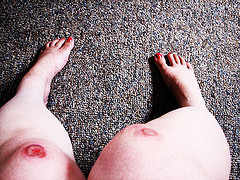 Sometimes the things that we enjoy doing can result in a few bruises, particularly if we enjoy energetic activities such as squash, paintballing, contact sports, or pole dancing. Often we can take measures to protect ourselves against bruises, for instance by wearing protective clothing and padding, but it is impossible to avoid them altogether. Here are a few tips for both preventing them and, when the do occur, for healing them.
Sometimes the things that we enjoy doing can result in a few bruises, particularly if we enjoy energetic activities such as squash, paintballing, contact sports, or pole dancing. Often we can take measures to protect ourselves against bruises, for instance by wearing protective clothing and padding, but it is impossible to avoid them altogether. Here are a few tips for both preventing them and, when the do occur, for healing them.
The Biology of Bruises
A bruise occurs when we break tiny blood vessels, capillaries, under the skin. Blood then seeps into the surrounding tissue which causes the tissue to darken and take on the characteristic appearance and coloring of a bruise as the hemoglobin in the blood breaks down. Eventually, after a few days, the body repairs the damaged tissue and the bruise fades away.
Sometimes bruises can occur in areas that are adjacent to the actual injury as blood seeps away from the injury and into surrounding tissue. Interestingly, as women have more subcutaneous tissue than men, they are also much more susceptible to bruising, and female redheads are the most susceptible of all.
How bruises occur and how to avoid them
The two most obvious ways of causing a bruise are by impact and pressure injuries. Although in most spots and physical activities we can wear padding and protective clothing to protect our most vulnerable areas from bruising, in others this is not possible.
A good example of the latter is pole dancing. This is rapidly becoming a very popular way of working out as it provides excellent cardiovascular exercise whilst building body tone and strength. If you are learning to pole dance, and particularly when you are moving on from the basics to some of the more complicated moves, it is almost inevitable that you will encounter the occasional fall. By ensuring that you are using a crash mat under the pole will help protected from bruising when you fall.
Pressure Bruises
Pressure bruises can occur when you are suspending yourself using soft areas of your body, for instance your thighs. These are particularly delicate areas and unfortunately it is not really possible to protect them with padding, as it is the friction between your skin and the pole that you are relying on to keep you attached to the pole. As in all sports, the best way to avoid pole dancing bruises is in proper preparation and execution. Make sure that you understand each move before you do it by visualising it. Take things slowly and step by step. Take plenty of rests and don’t overstress any particular area; you can do this by alternating between different parts of you body as you exercise.
A common cause of pressure bruising that beginners encounter is gripping too tightly or not tightly enough. This is because they overestimate or underestimate the amount of pressure that is required to keep them attached to the pole. Practice slowly until you find a balance between the amount of pressure needed to stop you sliding whilst not over-compressing and possibly bruising your body.
Treating bruises
Although there are many effective ways of treating bruises, in reality it is rarely necessary for a light to moderate bruise to need any treatment; it will simply fade away over time. The problem is that bruises can be unsightly, and although you might be able to cover them up, it night not be convenient or appropriate to do so.
The recommended first aid treatment for bruises is known as RICE, which stands for Rest, Ice, Compression, and Elevation. Rest means taking away any stress from the area; ice means cooling the area down (see below); compression, for instance by wearing an elastic bandage, can reduce swelling; and elevation, which means keeping the bruised area higher than the heart, helps the blood flow away from the injury which results in less bruising.
Taking a non-steroidal anti-inflammatory painkiller can significantly reduce bruising and help it fade more rapidly. The best painkillers for this are aspirin or ibuprofen, though Paracetamol can also be effective.
You can also decrease the time that it takes for a bruise to fade by using gentle stretching exercises but do not try this until you are happy that any other damage to the tissue has healed, and certainly not during the first three days after the bruise has appeared.
The best immediate action to take once you have sustained an injury is to apply ice to the area. This reduces the amount of blood that can leak into the tissue, and so reduce the severity of the bruise.
There are also some creams and ointments that will take away bruises. One of these is Hirudoid but there are many others. You simply rub them over the bruised area and they work by breaking down the blood that is causing the bruising. A natural medicinal treatment for bruising which has a similar effect to Hirudoid is Arnica Montana, or just Arnica. This ancient treatment is now a favourite amongst professional athletes and sportspeople.
This article was written by Caitlin a pole fitness fanatic who is well versed in bruises from dancing and now never dances without a pole dance mat. When she is not hanging upside-down from her X-Pole she also writes for poledancingpoles info, a site that specialises in comparing dance pole prices.



Leave a Reply